-
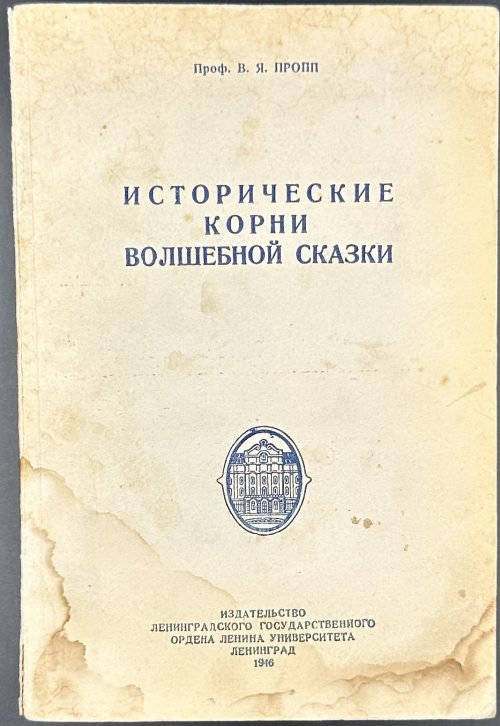 Paperback, 21.3 x 14.4 cm, 8vo, in original wrappers, lettered to front and spine, printed on brownish paper, previous owner's blue crayon manuscript, water stain to the outside, collated [1] 2-208 2110 (total 340 pp.); pp: [1-5] 6-340. Title-page: Пооф. В. Я. ПРОПП | ИСТОРИЧЕСКИЕ | КОРНИ | ВОЛШЕБНОЙ СКАЗКИ | ИЗДАТЕЛЬСТВО | ЛЕНИНГРАДСКОГО ГОСУДАРСТВЕННОГО | ОРДЕНА ЛЕНИНА УНИВЕРСИТЕТА | ЛЕНИНГРАД | 1946 || Print run: 10,000 copies. Contributors: Владимир Яковлевич Пропп [Vladimir Propp] (Russian, 1895 – 1970) For the circulation copy see [LIB-1710.2019] В. Я. Пропп. Исторические корни волшебной сказки (2-е изд.) — Л.: Изд-во ЛГУ, 1986. English title: [LIB-1615.2018] V. Propp. Morphology of the Folktale. — Austin: University of Texas Press, 1979.
Paperback, 21.3 x 14.4 cm, 8vo, in original wrappers, lettered to front and spine, printed on brownish paper, previous owner's blue crayon manuscript, water stain to the outside, collated [1] 2-208 2110 (total 340 pp.); pp: [1-5] 6-340. Title-page: Пооф. В. Я. ПРОПП | ИСТОРИЧЕСКИЕ | КОРНИ | ВОЛШЕБНОЙ СКАЗКИ | ИЗДАТЕЛЬСТВО | ЛЕНИНГРАДСКОГО ГОСУДАРСТВЕННОГО | ОРДЕНА ЛЕНИНА УНИВЕРСИТЕТА | ЛЕНИНГРАД | 1946 || Print run: 10,000 copies. Contributors: Владимир Яковлевич Пропп [Vladimir Propp] (Russian, 1895 – 1970) For the circulation copy see [LIB-1710.2019] В. Я. Пропп. Исторические корни волшебной сказки (2-е изд.) — Л.: Изд-во ЛГУ, 1986. English title: [LIB-1615.2018] V. Propp. Morphology of the Folktale. — Austin: University of Texas Press, 1979. -
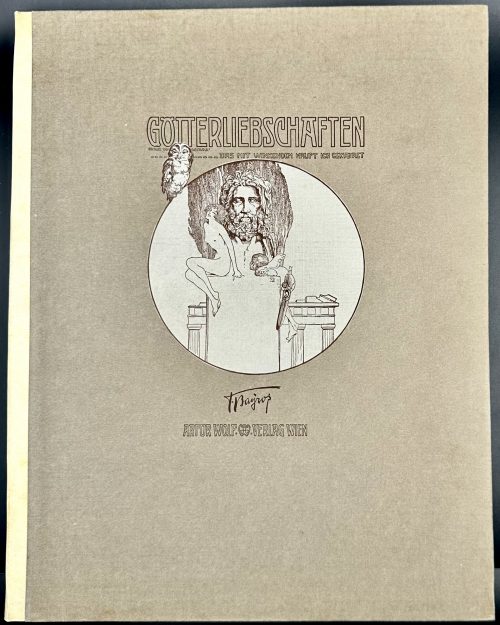 Letterpress title-page, engraved title-page, and 10 sheets of collotype plates printed on india paper mounted on thick wove paper, with captioned guard sheets, loose in a vellum-backed cardboard portfolio with cloth-mounted flaps; floral diaper design inside throughout; bookseller's label to front board verso; limited edition of 550 copies of which this is copy № 103. Dimensions: 338 x 268 mm portfolio; 325 x 260 mm sheet, 225 x 195 mm image. Front board with lettering and vignette: GÖTTERLIEBSCHAFTEN | DAS MIT WINKENDEM HAUPT ICH GEWAHRET | {vignette} | {signature} | ARTUR WOLF / VERLAG WIEN || Letterpress title-page: FRANZ VON BAYROS | “GÖTTERLIEBSCHAFTEN” | ARTUR WOLF / VERLAG WIEN | 1914 || Verso to letterpress t.p. VERZEICHNIS DER TAFELN.
Letterpress title-page, engraved title-page, and 10 sheets of collotype plates printed on india paper mounted on thick wove paper, with captioned guard sheets, loose in a vellum-backed cardboard portfolio with cloth-mounted flaps; floral diaper design inside throughout; bookseller's label to front board verso; limited edition of 550 copies of which this is copy № 103. Dimensions: 338 x 268 mm portfolio; 325 x 260 mm sheet, 225 x 195 mm image. Front board with lettering and vignette: GÖTTERLIEBSCHAFTEN | DAS MIT WINKENDEM HAUPT ICH GEWAHRET | {vignette} | {signature} | ARTUR WOLF / VERLAG WIEN || Letterpress title-page: FRANZ VON BAYROS | “GÖTTERLIEBSCHAFTEN” | ARTUR WOLF / VERLAG WIEN | 1914 || Verso to letterpress t.p. VERZEICHNIS DER TAFELN.- Europa und der Stier
- Leda und die Schildkröte
- Sterope und Herkules
- Herodikos und die Turnerinnen
- Phoroneus und die Hirtin
- Minos und Persipeia
- Phryne und Mutter
- Pytalos und Demeter
- Kirke und die Ferkel
- Putiphar
-
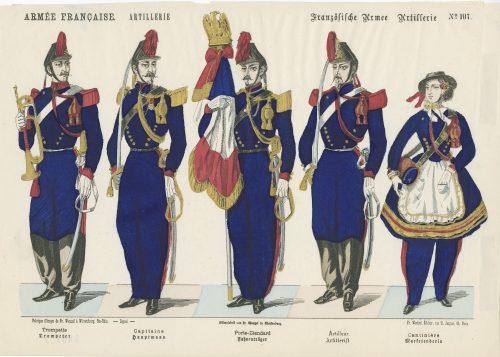 Hand-coloured woodcut on wove paper, 265 x 378 mm; black ink stamp “5051 1” to reverse. Top left: "ARMÉE FRANCAISE. ARTILLERIE"; right: (gothic font) "Französische Armee Artillerie" — "№ 107". Below left: "Fabrique d’Images de Fr. Wentzel à Wissembeurg. Bas-Rhin." — "Déposé" —, centre: "Bilderfabrit von Fr. Wentzel in Weissenburg", right: "Fr. Wentzel, Éditeur, rue St. Jacques, 65, Paris". Bottom: "Trompette | Trompeter" — "Capitaine | Gauptmann" — "Porte-Étendard | Fahnenträger" — "Artilleur | Artillerist" — "Cantinière | Marketenderin". Jean Frédéric Wentzel (French, 1807 – 1869) – publisher/printer.
Hand-coloured woodcut on wove paper, 265 x 378 mm; black ink stamp “5051 1” to reverse. Top left: "ARMÉE FRANCAISE. ARTILLERIE"; right: (gothic font) "Französische Armee Artillerie" — "№ 107". Below left: "Fabrique d’Images de Fr. Wentzel à Wissembeurg. Bas-Rhin." — "Déposé" —, centre: "Bilderfabrit von Fr. Wentzel in Weissenburg", right: "Fr. Wentzel, Éditeur, rue St. Jacques, 65, Paris". Bottom: "Trompette | Trompeter" — "Capitaine | Gauptmann" — "Porte-Étendard | Fahnenträger" — "Artilleur | Artillerist" — "Cantinière | Marketenderin". Jean Frédéric Wentzel (French, 1807 – 1869) – publisher/printer. -
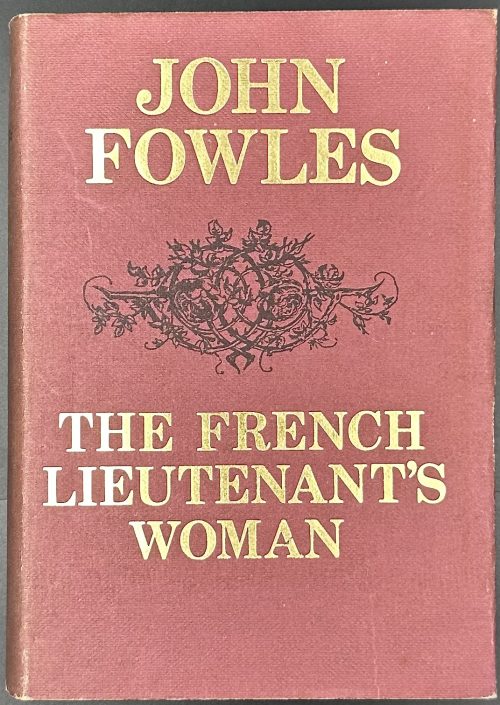 Hardcover volume, 20.2 x 14.5 cm, aubergine cloth, gilt lettering and publisher’s device to spine, aubergine top edge, aubergine dust jacket with gilt lettering and black fleuron to front, gilt lettering and black fleuron and publisher’s device to spine, and a captioned photographic portrait to back, blurb text to flaps, price ”35s net | in U.K. only” unclipped; pictorial endpapers. Pp.: [1-8] 9-445 [446] [2], collation: A-O16, total 224 leaves. Title-page (in oval frame): JOHN FOWLES | THE | FRENCH | LIEUTENANT'S | WOMAN | — | Every emancipation is a restoration of the human | world and of human relationships to man himself. | MARX, Zur Judenfrage (1844) | JONATHAN CAPE | THIRTY BEDFORD SQUARE | LONDON || Contributors: John Fowles (British, 1926 – 2005) – author. Herbert Jonathan Cape (British, 1879 – 1960) – publisher. Ebenezer Baylis & Son, Ltd. (f. 1858) – printer. The Trinity Press – printer.
Hardcover volume, 20.2 x 14.5 cm, aubergine cloth, gilt lettering and publisher’s device to spine, aubergine top edge, aubergine dust jacket with gilt lettering and black fleuron to front, gilt lettering and black fleuron and publisher’s device to spine, and a captioned photographic portrait to back, blurb text to flaps, price ”35s net | in U.K. only” unclipped; pictorial endpapers. Pp.: [1-8] 9-445 [446] [2], collation: A-O16, total 224 leaves. Title-page (in oval frame): JOHN FOWLES | THE | FRENCH | LIEUTENANT'S | WOMAN | — | Every emancipation is a restoration of the human | world and of human relationships to man himself. | MARX, Zur Judenfrage (1844) | JONATHAN CAPE | THIRTY BEDFORD SQUARE | LONDON || Contributors: John Fowles (British, 1926 – 2005) – author. Herbert Jonathan Cape (British, 1879 – 1960) – publisher. Ebenezer Baylis & Son, Ltd. (f. 1858) – printer. The Trinity Press – printer. -
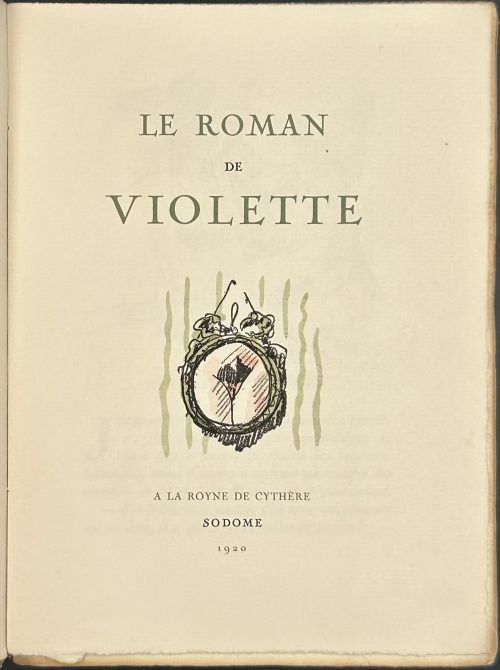 Softcover volume, 19.5 x 14.3 cm, olive French flapped wrappers, glassine dust cover, printed on laid paper (Hollande), outer and bottom margins untrimmed, some pages uncut; pagination: [2] blank, [i-iv] h.t./limit., t.p./blank, v-viii, 1-196 [197] [5], total 212 pages plus frontispiece; head- and tailpieces and in-text stencil-coloured etchings after Chéripoulos. Title-page (olive and black): LE ROMAN | DE | VIOLETTE | {vignette} | A LA ROYNE DE CYTHÈRE | SODOME | 1920 || Limitation: Cet ouvrage, achevé d'imprimer le cinq Janvier Mil Neuf Cent Vingt à trois cents exemplaires dont vingt-cinq exemplaires sur Japon Impérial contenant chacun un dessin original de Chéripoulos, numérotés de un à vingt-cinq; deux cent soixante-quinze exemplaires sur papier de Hollande, numérotés de vingt-six à trois cents; en plus cinq exemplaires de collaborateurs marqués de A à E. Le présent exemplaire porte le numéro 72. Edition: Printed on the 5th of January 1920 in 305 copies (№№ 1-25 on Japon Impérial, №№ 26-300 on Hollande, A–E for collaborators). Catalogue raisonné: Dutel III № 2339, p. 350. Contributors: Henriette de Mannoury d'Ectot [Henriette Nicolas Le Blanc] (French 1815 – 1899) Charles Auguste Edelmann [Chéripoulos] (French, 1879 – 1950).
Softcover volume, 19.5 x 14.3 cm, olive French flapped wrappers, glassine dust cover, printed on laid paper (Hollande), outer and bottom margins untrimmed, some pages uncut; pagination: [2] blank, [i-iv] h.t./limit., t.p./blank, v-viii, 1-196 [197] [5], total 212 pages plus frontispiece; head- and tailpieces and in-text stencil-coloured etchings after Chéripoulos. Title-page (olive and black): LE ROMAN | DE | VIOLETTE | {vignette} | A LA ROYNE DE CYTHÈRE | SODOME | 1920 || Limitation: Cet ouvrage, achevé d'imprimer le cinq Janvier Mil Neuf Cent Vingt à trois cents exemplaires dont vingt-cinq exemplaires sur Japon Impérial contenant chacun un dessin original de Chéripoulos, numérotés de un à vingt-cinq; deux cent soixante-quinze exemplaires sur papier de Hollande, numérotés de vingt-six à trois cents; en plus cinq exemplaires de collaborateurs marqués de A à E. Le présent exemplaire porte le numéro 72. Edition: Printed on the 5th of January 1920 in 305 copies (№№ 1-25 on Japon Impérial, №№ 26-300 on Hollande, A–E for collaborators). Catalogue raisonné: Dutel III № 2339, p. 350. Contributors: Henriette de Mannoury d'Ectot [Henriette Nicolas Le Blanc] (French 1815 – 1899) Charles Auguste Edelmann [Chéripoulos] (French, 1879 – 1950). -
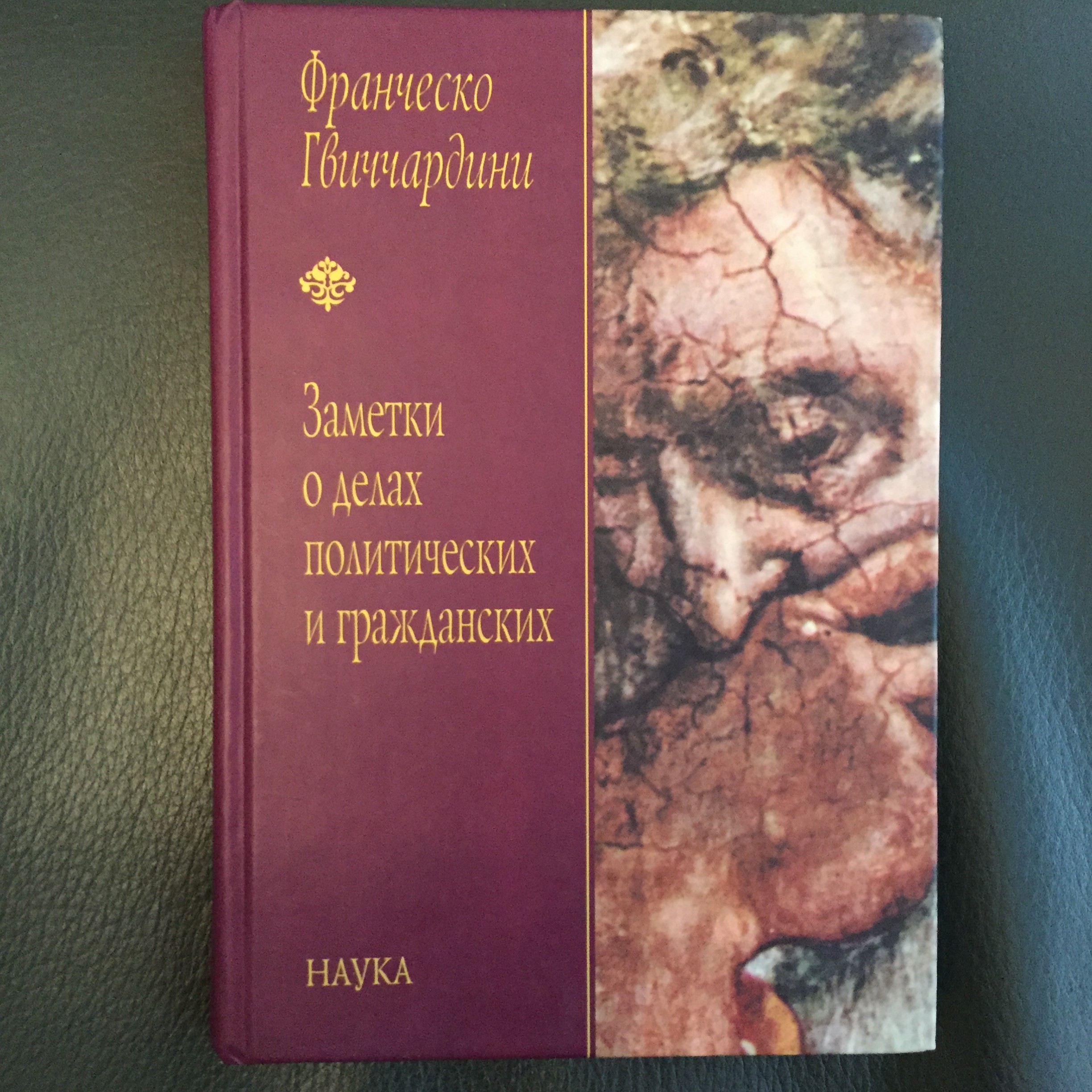
Франческо Гвиччардини. Заметки о делах политических и гражданских (Ricordi politici e civili). Пер. с итал. М.С.Фельдштейна под ред. Г.Д. Муравьевой; [Авт. вступ. ст. и прим., сост. библиогр., отв. ред. Л.М. Брагина; Рос. акад. наук. Науч. совет "История мировой культуры". Комис. по культуре Возрождения]. -- М.: Наука, 2004. -- 195 стр. Тир. 700 экз.
-
 Artist: Utagawa Kunisada [歌川 国貞] a.k.a. Utagawa Toyokuni III [三代歌川豊国] (Japanese, 1786 – 1865). Signed: Ōju Toyokuni ga [応需豊国画], in a toshidama cartouche. Double nanushi censor seals: Mera & Murata (1846-50). Publisher: Kojimaya Jūbei [小嶋屋重兵衛] (Japanese, fl. c. 1797 – 1869). A beautiful woman, possibly a kabuki actor Iwai Hanshirō VIII [岩井半四郎] (Iwai Shijaku II, Iwai Kumesaburō III [岩井粂三郎], Iwai Hisajirō II, Japanese, 1829 – 1882), tuning the samisen on a veranda under the shining stars. The complete set of series Moon, Sun, Stars [月日星] (tsuki-hi-hoshi/boshi), three sources of light (sankō) [三光]:
Artist: Utagawa Kunisada [歌川 国貞] a.k.a. Utagawa Toyokuni III [三代歌川豊国] (Japanese, 1786 – 1865). Signed: Ōju Toyokuni ga [応需豊国画], in a toshidama cartouche. Double nanushi censor seals: Mera & Murata (1846-50). Publisher: Kojimaya Jūbei [小嶋屋重兵衛] (Japanese, fl. c. 1797 – 1869). A beautiful woman, possibly a kabuki actor Iwai Hanshirō VIII [岩井半四郎] (Iwai Shijaku II, Iwai Kumesaburō III [岩井粂三郎], Iwai Hisajirō II, Japanese, 1829 – 1882), tuning the samisen on a veranda under the shining stars. The complete set of series Moon, Sun, Stars [月日星] (tsuki-hi-hoshi/boshi), three sources of light (sankō) [三光]: -

Hardcover, green cloth stamped with title to front cover and spine, pictorial DJ, pp.: [10] 1-206.
Introduction / Andreas Marks -- An artistic collaboration: travelling the Tōkaidō with Kuniyoshi, Hiroshige, and Kunisada / Laura W. Allen Folklore and legend in the fifty-three pairings along the Tōkaidō / Ann Wehmeyer The plates. Tōkaidō gojūsan tsui / transcription and translation by Ann Wehmeyer ; notes by Ann Wehmeyer and Andreas Marks.ISBN: 9780813060217
-
 Copper (suaka) tsuba of oval form carved in relief, pierced and inlaid with soft metals (gold, shakudō, shibuichi or silver) with a cormorant fisherman (ushō) and moon motif on the face and a boat among the bank reeds on the reverse. Signed: Nagatsune. Box inscription: Tsuba with cormorant fishing, made by Nagatsune. Dimensions: 62.7 mm x 53.2 mm x 4.2 mm (at seppa-dai) Edo period: 18th century. Nagatsune (1721-1787), 1st generation master of Inchinomiya School in Kyoto, adopted son of the gilder Nagayoshi, student of Yasui Takanaga [M. Sesko 'Genealogies', p. 26]. Detailed account of the school is given at The Japanese toso-kinko Schools.// Lulu Inc., 2012 by Markus Sesko, pp. 104-108. Nagatsune's biographical sketch can be found there on pp. 104-106. "What Sōminis in the East (Edo), Nagatsune is in the West (Kyōto)." “Since Nara period, Japanese fishermen in small boats have used cormorants (u) to catch river fish at night, binding the necks of the birds so that the fish are not swallowed. […] The bird and the work it performs are symbols of selfless devotion to one’s master and keen eyesight.” – from Merrily Baird 'Symbols of Japan. Thematic motifs in art and design.' //Rizzoli international publications, Inc., 2001; p. 104. See also in this collection: TSU-241 and TSU-0096
Copper (suaka) tsuba of oval form carved in relief, pierced and inlaid with soft metals (gold, shakudō, shibuichi or silver) with a cormorant fisherman (ushō) and moon motif on the face and a boat among the bank reeds on the reverse. Signed: Nagatsune. Box inscription: Tsuba with cormorant fishing, made by Nagatsune. Dimensions: 62.7 mm x 53.2 mm x 4.2 mm (at seppa-dai) Edo period: 18th century. Nagatsune (1721-1787), 1st generation master of Inchinomiya School in Kyoto, adopted son of the gilder Nagayoshi, student of Yasui Takanaga [M. Sesko 'Genealogies', p. 26]. Detailed account of the school is given at The Japanese toso-kinko Schools.// Lulu Inc., 2012 by Markus Sesko, pp. 104-108. Nagatsune's biographical sketch can be found there on pp. 104-106. "What Sōminis in the East (Edo), Nagatsune is in the West (Kyōto)." “Since Nara period, Japanese fishermen in small boats have used cormorants (u) to catch river fish at night, binding the necks of the birds so that the fish are not swallowed. […] The bird and the work it performs are symbols of selfless devotion to one’s master and keen eyesight.” – from Merrily Baird 'Symbols of Japan. Thematic motifs in art and design.' //Rizzoli international publications, Inc., 2001; p. 104. See also in this collection: TSU-241 and TSU-0096The design was popular among the tsuba makers. We find one in the Alexander G. Moslé collection [Japanese Sword Fittings from the Alexander G. Moslé Collection; Sebastian Izzard LLC, 2004, page 90, №123] signed Nagatsune with kaō: Tsuba with cormorant fisherman, moon, and boat. Squared-oval shibuichi plate, slightly raised rim, engraved, pierced, and inlaid with soft metals in relief. 6.7 x 5.8 cm.

Alexander G. Moslé collection №123.
Another reference: Lundgren Collection, 1990, page 86 №207: Sword guard with design of ushō (person who fishes with cormorants). Signed by Nagatsune. Ichinomiya school. 6.45 x 5.95 x 0.40 cm. Polished shibuichi taka-bori relief, gold and silver inlay. Edo period, 18th century.

Lundgren Collection №207:
-
 Iron tsuba of slightly elongated round form decorated with three pairs of snowflake-form small perforations (ko-sukashi), each outlined with brass wire; five concentric circular rows of dots inlaid in brass or copper ten-zōgan (some dots are missing). Hitsu-ana of oval form. Ōnin school. Unsigned. Late Muromachi period. Dimensions: 75.6 mm x74.6 mm x 3.0 mm. Weight: 78.0 g. Old NBTHK certificate (green paper): Tokubetsu Kicho - "Extraordinary Work". Unlike most Ōnin ten-zōgan tsuba this one does not have circular brass wire inlay inside the dots area; neither it has brass trim around seppa-dai or hitsu-ana.
Iron tsuba of slightly elongated round form decorated with three pairs of snowflake-form small perforations (ko-sukashi), each outlined with brass wire; five concentric circular rows of dots inlaid in brass or copper ten-zōgan (some dots are missing). Hitsu-ana of oval form. Ōnin school. Unsigned. Late Muromachi period. Dimensions: 75.6 mm x74.6 mm x 3.0 mm. Weight: 78.0 g. Old NBTHK certificate (green paper): Tokubetsu Kicho - "Extraordinary Work". Unlike most Ōnin ten-zōgan tsuba this one does not have circular brass wire inlay inside the dots area; neither it has brass trim around seppa-dai or hitsu-ana. -
 Two ymagane tsuba (daisho) with chiseled diaper pattern of waves. The larger tsuba (dai) is of mokkō form with a wide (4.6 mm) polished rim (fukurin?). Water spray is realized in copper ten-zōgan. Size: 75.0 x 71.6 x 3.2 (center), 4.0 (rim) mm. Copper sekigane. The smaller tsuba (sho) is of oval form, without a rim. No inlay. Size: 53.2 x 45.5 x 4.1 mm. Ko-kinko school. Muromachi period. In Kokusai Tosogu Kai; 5th International Convention & Exhibition, 2009 on page 51 under № 5-U8 there is a piece from George Gaucys collection, described as follows: Unsigned Tachi-Kanagushi tsuba, Yamagane base. Nami (wave) motif. Circa: Muromachi period (15th century). 6.88 x 6.81 x 0.45 (rim), 0.36 (center). The classic wave form is typically seen in Muromachi period tosogu. The patina is rich and rustic, which presents history and warmth. This tsuba may be interpreted as either tachi-kanagushi or ko-kinko work. Early tachi tsuba were symmetrical in design and also not very sophisticated, Design elements filled in up to seppadai as the waves do in this tsuba. There is a simple fikurin of the same metal and it is flat to the plate. On the ko-kinko side, the crests of the waves show more complexity than tachi works and less symmetry. A very intriguing tsuba from late Muromachi period."
Two ymagane tsuba (daisho) with chiseled diaper pattern of waves. The larger tsuba (dai) is of mokkō form with a wide (4.6 mm) polished rim (fukurin?). Water spray is realized in copper ten-zōgan. Size: 75.0 x 71.6 x 3.2 (center), 4.0 (rim) mm. Copper sekigane. The smaller tsuba (sho) is of oval form, without a rim. No inlay. Size: 53.2 x 45.5 x 4.1 mm. Ko-kinko school. Muromachi period. In Kokusai Tosogu Kai; 5th International Convention & Exhibition, 2009 on page 51 under № 5-U8 there is a piece from George Gaucys collection, described as follows: Unsigned Tachi-Kanagushi tsuba, Yamagane base. Nami (wave) motif. Circa: Muromachi period (15th century). 6.88 x 6.81 x 0.45 (rim), 0.36 (center). The classic wave form is typically seen in Muromachi period tosogu. The patina is rich and rustic, which presents history and warmth. This tsuba may be interpreted as either tachi-kanagushi or ko-kinko work. Early tachi tsuba were symmetrical in design and also not very sophisticated, Design elements filled in up to seppadai as the waves do in this tsuba. There is a simple fikurin of the same metal and it is flat to the plate. On the ko-kinko side, the crests of the waves show more complexity than tachi works and less symmetry. A very intriguing tsuba from late Muromachi period."
Kokusai Tosogu Kai 5th, 2009, p. 51, № 5-U8: ko-kinko or tachi-kanagushi tsuba.
-
 Ko-kinko ymagane cast tsuba of mokko form (kirikomi-mokkō-gata) with chiseled diaper pattern of double head waves on both sides and a rabbit cast and carved with its eye inlaid in yellow metal (gold or brass) on the face. Fukurin which holds together the sandwiched layers of metal (sanmai) is about 2.4 mm wide. A look-a-like tsub of oval form instead of mokko-gata is illustrated at Robert E. Haynes's Catalog #3,1982 on page 11, lot 15: "Rare design in style of Sanmai (three layers) / Wasei work. With yamagane core and heavy rim cover. The web plates are carved with double head Goto style waves and the face has a fox. The web plates were riveted at the seppadai. See Lot 4, page 8. Ca. 1350. Ht. 6.6 cm, th. 3 mm" [underscore mine]. Quality of photo is so poor that I decided not to provide it here. Muromachi (if we follow Robert) or Momoyama period. The Momoyama attribution is mostly based on a fact that "waves and rabbit" motif became most popular in Momoyama times. Size: 68.5 x 59.8 x 4.0 mm. NBTHK Certificate № 423120. This tsuba is listed at Yakiba website with the following passage: "Attributions as well as dating of this type of tsuba has been the subject debate over the years. There are those who believe these type of tsuba to be ko-Mino (early Mino School) tsuba, others believe them to be tachi-kanaguchi tsuba. Still others insist they are simply ko-kinko (early soft metal) tsuba. This tsuba was authenticated and determined to be "Ko-Kinko" by the NBTHK". Oval form tsuba with the same design can be found in this collection - TSU-0323.
Ko-kinko ymagane cast tsuba of mokko form (kirikomi-mokkō-gata) with chiseled diaper pattern of double head waves on both sides and a rabbit cast and carved with its eye inlaid in yellow metal (gold or brass) on the face. Fukurin which holds together the sandwiched layers of metal (sanmai) is about 2.4 mm wide. A look-a-like tsub of oval form instead of mokko-gata is illustrated at Robert E. Haynes's Catalog #3,1982 on page 11, lot 15: "Rare design in style of Sanmai (three layers) / Wasei work. With yamagane core and heavy rim cover. The web plates are carved with double head Goto style waves and the face has a fox. The web plates were riveted at the seppadai. See Lot 4, page 8. Ca. 1350. Ht. 6.6 cm, th. 3 mm" [underscore mine]. Quality of photo is so poor that I decided not to provide it here. Muromachi (if we follow Robert) or Momoyama period. The Momoyama attribution is mostly based on a fact that "waves and rabbit" motif became most popular in Momoyama times. Size: 68.5 x 59.8 x 4.0 mm. NBTHK Certificate № 423120. This tsuba is listed at Yakiba website with the following passage: "Attributions as well as dating of this type of tsuba has been the subject debate over the years. There are those who believe these type of tsuba to be ko-Mino (early Mino School) tsuba, others believe them to be tachi-kanaguchi tsuba. Still others insist they are simply ko-kinko (early soft metal) tsuba. This tsuba was authenticated and determined to be "Ko-Kinko" by the NBTHK". Oval form tsuba with the same design can be found in this collection - TSU-0323.
TSU-0323. Ko-kinko yamagane tsuba with waves and rabbit motif.
-
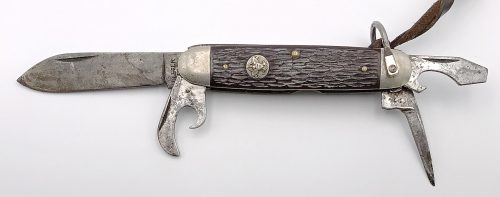
Ulster Official Scout pocket knife with brown jigged bone plastic handles.
Size: 93 mm (closed); 160 mm (opened); 70 mm blade.
Tang is etched with: Ulster -
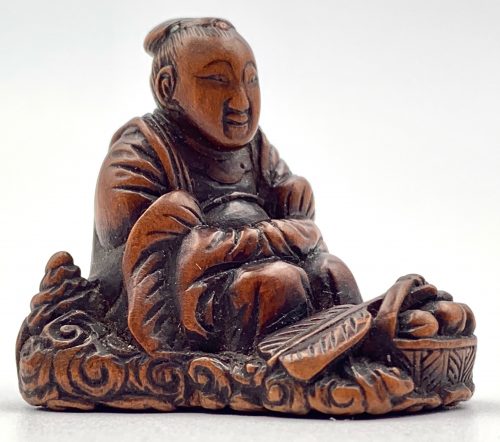 Wood netsuke of Seiōbo with a basket of immortal peaches, seated on a bed of clouds. Carver's signature tablet lost. Circa 1850. Dimensions: 32.6 x 28.1 x 20.1 mm.
Wood netsuke of Seiōbo with a basket of immortal peaches, seated on a bed of clouds. Carver's signature tablet lost. Circa 1850. Dimensions: 32.6 x 28.1 x 20.1 mm.Queen Mother of the West is a calque of Xiwangmu in Chinese sources, Seiōbo in Japan. Peaches of Immortality (Chinese: 仙桃) are consumed by the immortals due to their mystic virtue of conferring longevity on all who eat them.
Provenance: Charles Ephrussi (1849-1905) acquired in the 1870s; a wedding gift in 1898 to his cousin Ritter Viktor von Ephrussi (1860-1945) and Baroness Emilie (Emmy) Schey von Koromla (1879-1938); retrieved post-war by their daughter Elizabeth de Waal (1899-1991); given by her to her brother Ignaz (Iggie) Ephrussi (1906-1994), Tokyo; bequeathed by him to his great-nephew Edmund de Waal (born 1964), London, author of “The Hare with Amber Eyes: a hidden inheritance”. London / New York: Chatto & Windus / Farrar, Straus & Giroux. ISBN 978-0099539551. https://en.wikipedia.org/wiki/Charles_Ephrussi. https://en.wikipedia.org/wiki/Ephrussi_family. https://en.wikipedia.org/wiki/Edmund_de_Waal. -
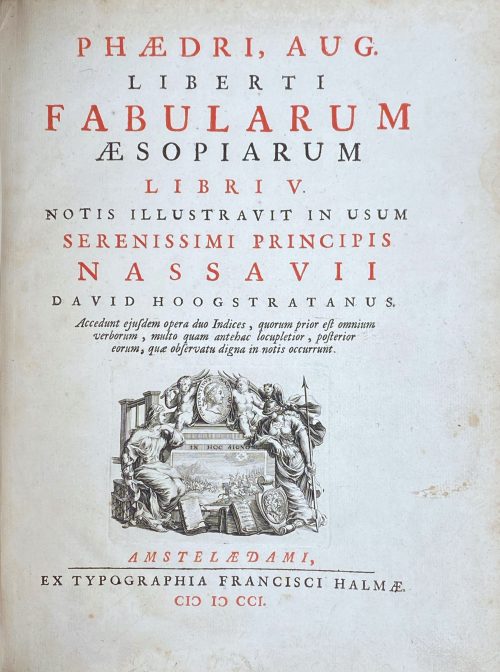 Phaedri, Aug. Liberti Fabularum Aesopiarum libri V / notis illustravit in usum serenissimi principis Nassavii David Hoogstratanus. Accedunt ejusdem opera duo indices, quorum prior est omnium verborum, multo quam antehac locupletior, posterior eorum, quae observatu digna in notis occurunt. — Amstelaedami : Ex Typographia Francisci Halmae, MDCCI [1701]. — pp.: [1] title, [1] (portr.), [32] 160, [84], 18 leaves of plates. Vita Phaedri is written by Johannes Schefferus (February 2, 1621 – March 26, 1679). Appendix fabularum is written by Marquard Gude (Gudius) (1 February 1635 – 26 November 1689). Gaius Julius Phaedrus was a 1st-century CE Roman fabulist and the first versifier of a collection of Aesop's fables into Latin. David van Hoogstraten (Rotterdam, March 14, 1658 - Amsterdam, November 21, 1724), a physician, poet and linguist, annotated the fables and dedicated them to Johan Willem Friso van Oranje-Nassau (14 August 1687 – 14 July 1711). The book was published in Amsterdam by François Halma (Langerak, January 3, 1653 - Leeuwarden, January 13, 1722), a Dutch printer, publisher and bookseller, with a portrait of Prince of Orange-Nassau, engraved by Pieter van Gunst (Dutch, Amsterdam 1659–1724) after Bernard Vaillant (Dutch, Lille 1632–1698 Leyden). The title page was engraved by P. Boutats after Jan Goeree (Dutch, Middelburg 1670–1731 Amsterdam). The edition is adorned throughout with 18 plates, each with 8 médaillons, designed and engraved by Jan van Vianen (Dutch, 1660–1726), and with vignettes, head- and tailpieces, inhabited initials, etc. Contemporary vellum over boards, title in red and back, red edges, 4to, 26 x 20 cm. Seller's description:4to, engraved general title, letterpress red & black title page with allegorical engraved vignette. 18 full-page copper-engraved plates by Jan van Vianen, each featuring six circular images, and 38 in-text reproductions, engraved decorative initials, and head- and tailpieces. Phaedrus (15 BC - 50 AD, Italy), was a "Roman fabulist, the first writer to Latinize whole books of fables, producing free versions in the iambic metre of Greek prose fables then circulating under the name of Aesop." (Ency. Brit.). This deluxe edition was specially created for the Prince of Nassau, profusely illustrated with fine engravings. Dibdin spoke highly of it in his Greek and Latin Classics (4th edition): "I have always considered this as a correct and very sumptuous edition. It is ornamented with a great number of small plates, or medallions, in which the subject of the fable is very ably and spiritedly executed.Ref.: Metropolitan Museum; Musée Médard
Phaedri, Aug. Liberti Fabularum Aesopiarum libri V / notis illustravit in usum serenissimi principis Nassavii David Hoogstratanus. Accedunt ejusdem opera duo indices, quorum prior est omnium verborum, multo quam antehac locupletior, posterior eorum, quae observatu digna in notis occurunt. — Amstelaedami : Ex Typographia Francisci Halmae, MDCCI [1701]. — pp.: [1] title, [1] (portr.), [32] 160, [84], 18 leaves of plates. Vita Phaedri is written by Johannes Schefferus (February 2, 1621 – March 26, 1679). Appendix fabularum is written by Marquard Gude (Gudius) (1 February 1635 – 26 November 1689). Gaius Julius Phaedrus was a 1st-century CE Roman fabulist and the first versifier of a collection of Aesop's fables into Latin. David van Hoogstraten (Rotterdam, March 14, 1658 - Amsterdam, November 21, 1724), a physician, poet and linguist, annotated the fables and dedicated them to Johan Willem Friso van Oranje-Nassau (14 August 1687 – 14 July 1711). The book was published in Amsterdam by François Halma (Langerak, January 3, 1653 - Leeuwarden, January 13, 1722), a Dutch printer, publisher and bookseller, with a portrait of Prince of Orange-Nassau, engraved by Pieter van Gunst (Dutch, Amsterdam 1659–1724) after Bernard Vaillant (Dutch, Lille 1632–1698 Leyden). The title page was engraved by P. Boutats after Jan Goeree (Dutch, Middelburg 1670–1731 Amsterdam). The edition is adorned throughout with 18 plates, each with 8 médaillons, designed and engraved by Jan van Vianen (Dutch, 1660–1726), and with vignettes, head- and tailpieces, inhabited initials, etc. Contemporary vellum over boards, title in red and back, red edges, 4to, 26 x 20 cm. Seller's description:4to, engraved general title, letterpress red & black title page with allegorical engraved vignette. 18 full-page copper-engraved plates by Jan van Vianen, each featuring six circular images, and 38 in-text reproductions, engraved decorative initials, and head- and tailpieces. Phaedrus (15 BC - 50 AD, Italy), was a "Roman fabulist, the first writer to Latinize whole books of fables, producing free versions in the iambic metre of Greek prose fables then circulating under the name of Aesop." (Ency. Brit.). This deluxe edition was specially created for the Prince of Nassau, profusely illustrated with fine engravings. Dibdin spoke highly of it in his Greek and Latin Classics (4th edition): "I have always considered this as a correct and very sumptuous edition. It is ornamented with a great number of small plates, or medallions, in which the subject of the fable is very ably and spiritedly executed.Ref.: Metropolitan Museum; Musée Médard -
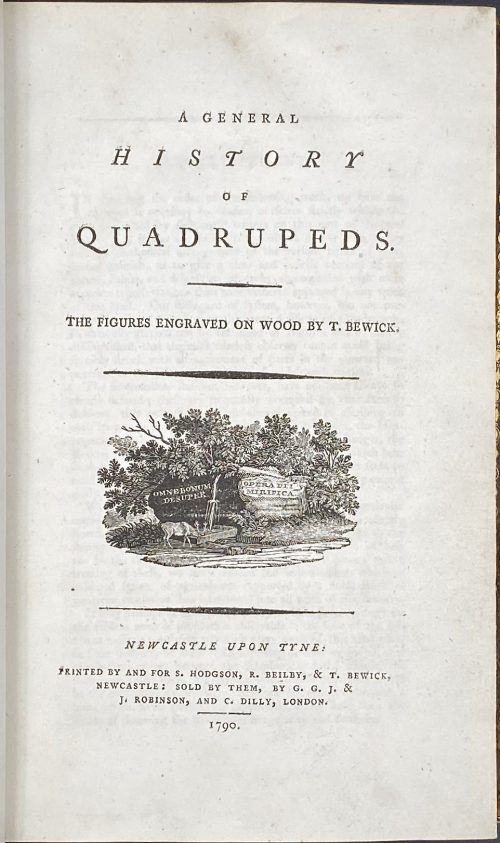 Title: A GENERAL | HISTORY | OF | QUADRUPEDS. | – | THE FIGURES ENGRAVED ON WOOD BY THOMAS BEWICK. | {vignette} | — | NEWCASTLE UPON TYNE : | PRINTED BY AND FOR S. HODGSON, R. BEILBY, & T. BEWICK, | NEWCASTLE: SOLD BY THEM, BY G. G. J. & | J. ROBINSON, AND C. DILLY, LONDON. | 1790. Pagination: [4 blanks], [i, ii] – t.p. / blank, [iii, iv] – advertisement / index, v-viii – index, [1] 2-456 [4 blanks]. Collation: demi 8vo; a⁴ A-Ee⁸ Ff⁴. A3 unsigned, catchword at p.375 THE instead of WE. Variant A (with a fly facing upward). Size: 21.8 x 14 cm; page 21.2 x 13 cm. Woodcuts: 260 descriptions of quadrupeds; 200 figures of quadrupeds, 104 vignettes, tailpieces, etc. Binding: Full marbled calf, gilt double border, black label with gilt lettering to flat spine. There were 1,500 copies Demy copies printed. Catalogue raisonné: S. Roscoe (1953): pp. 5-11; Hugo (1866): pp. 22-23.
Title: A GENERAL | HISTORY | OF | QUADRUPEDS. | – | THE FIGURES ENGRAVED ON WOOD BY THOMAS BEWICK. | {vignette} | — | NEWCASTLE UPON TYNE : | PRINTED BY AND FOR S. HODGSON, R. BEILBY, & T. BEWICK, | NEWCASTLE: SOLD BY THEM, BY G. G. J. & | J. ROBINSON, AND C. DILLY, LONDON. | 1790. Pagination: [4 blanks], [i, ii] – t.p. / blank, [iii, iv] – advertisement / index, v-viii – index, [1] 2-456 [4 blanks]. Collation: demi 8vo; a⁴ A-Ee⁸ Ff⁴. A3 unsigned, catchword at p.375 THE instead of WE. Variant A (with a fly facing upward). Size: 21.8 x 14 cm; page 21.2 x 13 cm. Woodcuts: 260 descriptions of quadrupeds; 200 figures of quadrupeds, 104 vignettes, tailpieces, etc. Binding: Full marbled calf, gilt double border, black label with gilt lettering to flat spine. There were 1,500 copies Demy copies printed. Catalogue raisonné: S. Roscoe (1953): pp. 5-11; Hugo (1866): pp. 22-23. -
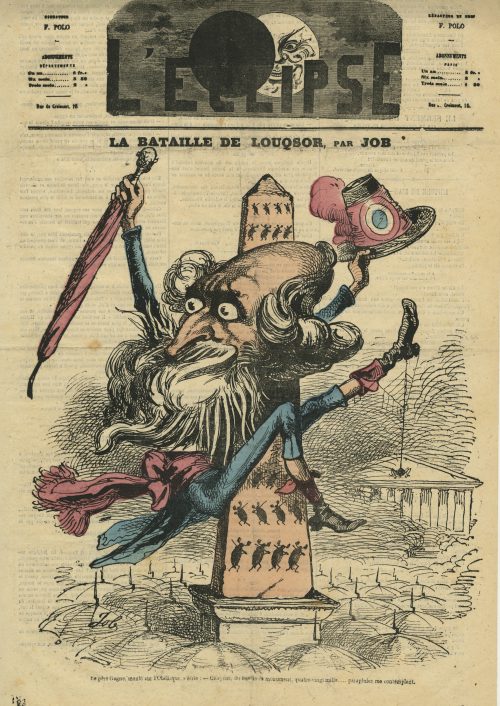 L'Éclipse : journal hebdomadaire, №94, 07-11-1869. La Bataille de Louqsor, par Job. [The Battle of Louqsor, by Job]. Le père Gagne, monté sur l'Obélisque, s'écrie: — Citoyens, du bas de ce monument, quatre-vingt mille…..parapluies me contemplent. [The father Gagne mounted on the Obelisk, cries out: — Citizens, from the bottom of the monument, eighty thousand….umberellas contemplate me]. Étienne-Paulin Gagne, known as Paulin Gagne (French, 1808 – 1876), holding a hat with a tricolour cockade and umbrella with the head of a devil on its grip straddles the obelisk of Luxor at the centre of the Place de la Concorde with marching scarabs on it. A spider dangles from his heel. In the background is The Palais Bourbon, a meeting place of the French National Assembly. The ground is made out of open umbrellas. Paulin Gagne was a graphomaniac poet, essayist, lawyer, politician, inventor, and eccentric, and a perpetual candidate for the Assembly. Ref.: Gallica; Bibliothèque nationale de France, département Philosophie, histoire, sciences de l'homme, FOL-LC13-114
L'Éclipse : journal hebdomadaire, №94, 07-11-1869. La Bataille de Louqsor, par Job. [The Battle of Louqsor, by Job]. Le père Gagne, monté sur l'Obélisque, s'écrie: — Citoyens, du bas de ce monument, quatre-vingt mille…..parapluies me contemplent. [The father Gagne mounted on the Obelisk, cries out: — Citizens, from the bottom of the monument, eighty thousand….umberellas contemplate me]. Étienne-Paulin Gagne, known as Paulin Gagne (French, 1808 – 1876), holding a hat with a tricolour cockade and umbrella with the head of a devil on its grip straddles the obelisk of Luxor at the centre of the Place de la Concorde with marching scarabs on it. A spider dangles from his heel. In the background is The Palais Bourbon, a meeting place of the French National Assembly. The ground is made out of open umbrellas. Paulin Gagne was a graphomaniac poet, essayist, lawyer, politician, inventor, and eccentric, and a perpetual candidate for the Assembly. Ref.: Gallica; Bibliothèque nationale de France, département Philosophie, histoire, sciences de l'homme, FOL-LC13-114 -
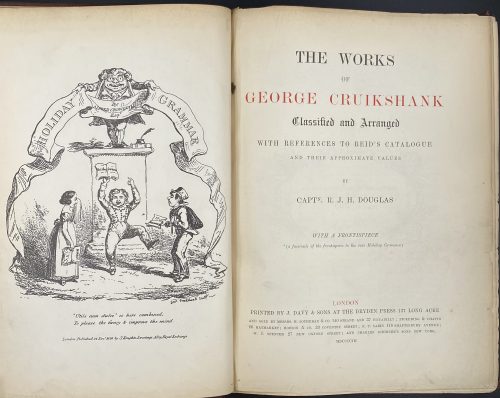 Half-title: THE WORKS | OF | GEORGE CRUIKSHANK | CLASSIFIED AND ARRANGED.|| Title: (in black and red) THE WORKS | OF | GEORGE CRUIKSHANK | CLASSIFIED AND ARRANGED | WITH REFERENCES TO REID'S CATALOGUE | AND THEIR APPROXIMATE VALUES| BY | CAPTN. R. J. H. DOUGLAS | WITH A FRONTISPIECE | (a facsimile of the frontispiece to the rare Holiday Grammar) | LONDON | PRINTED BY J. DAVY & SONS AT THE DRYDEN PRESS 137 LONG ACRE | AND SOLD BY MESSRS. H. SOTHERAN & CO. 140 STRAND AND 37 PICADILLY ; PICKERING & CATTO | 66 HAYMARKET ; ROBSON & CO 23 COVENTRY STREET ; F. T. SABIN 118 SHAFTESBURY AVENUE ; | W. T. SPENSER 27 NEW OXFORD STREET ; AND CHARLES SCRIBNER’S SONS NEW YORK. | MDCCCCIII || Imprint (title verso): One Thousand Copies of this book have been printed and the type distributed. This is No. 205. Bookplate to recto ffl: Reference Library of Francis Edwards Ltd. Not for sale. Inscription to recto ffl: “With the author’s compliments”. Pagination: ffl, [i, ii] – h.t. / blank, [2] – blank / frontis., [iii, iv] – t.p. (black and red) / Print run, [v] v-vi –preface, [2] – contents, [2] – f.t. / note; [1] 2-301 [302] – colophon; insert one sheet with type writing on Francis Edwards letterhead, bfl. (OCLC: ix, 302 pages : illustrations ; 26 cm) Collation: [A]5 B-T8 U7 Binding: Hardcover, burgundy cloth gilt-stamped with title and publisher’s device to front board and gilt lettering to spine.
Half-title: THE WORKS | OF | GEORGE CRUIKSHANK | CLASSIFIED AND ARRANGED.|| Title: (in black and red) THE WORKS | OF | GEORGE CRUIKSHANK | CLASSIFIED AND ARRANGED | WITH REFERENCES TO REID'S CATALOGUE | AND THEIR APPROXIMATE VALUES| BY | CAPTN. R. J. H. DOUGLAS | WITH A FRONTISPIECE | (a facsimile of the frontispiece to the rare Holiday Grammar) | LONDON | PRINTED BY J. DAVY & SONS AT THE DRYDEN PRESS 137 LONG ACRE | AND SOLD BY MESSRS. H. SOTHERAN & CO. 140 STRAND AND 37 PICADILLY ; PICKERING & CATTO | 66 HAYMARKET ; ROBSON & CO 23 COVENTRY STREET ; F. T. SABIN 118 SHAFTESBURY AVENUE ; | W. T. SPENSER 27 NEW OXFORD STREET ; AND CHARLES SCRIBNER’S SONS NEW YORK. | MDCCCCIII || Imprint (title verso): One Thousand Copies of this book have been printed and the type distributed. This is No. 205. Bookplate to recto ffl: Reference Library of Francis Edwards Ltd. Not for sale. Inscription to recto ffl: “With the author’s compliments”. Pagination: ffl, [i, ii] – h.t. / blank, [2] – blank / frontis., [iii, iv] – t.p. (black and red) / Print run, [v] v-vi –preface, [2] – contents, [2] – f.t. / note; [1] 2-301 [302] – colophon; insert one sheet with type writing on Francis Edwards letterhead, bfl. (OCLC: ix, 302 pages : illustrations ; 26 cm) Collation: [A]5 B-T8 U7 Binding: Hardcover, burgundy cloth gilt-stamped with title and publisher’s device to front board and gilt lettering to spine.





